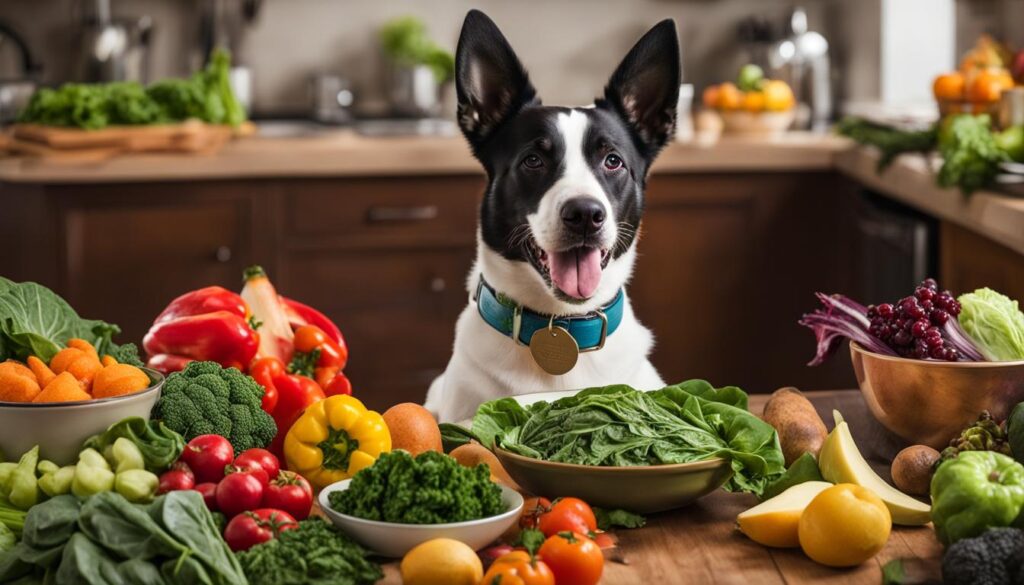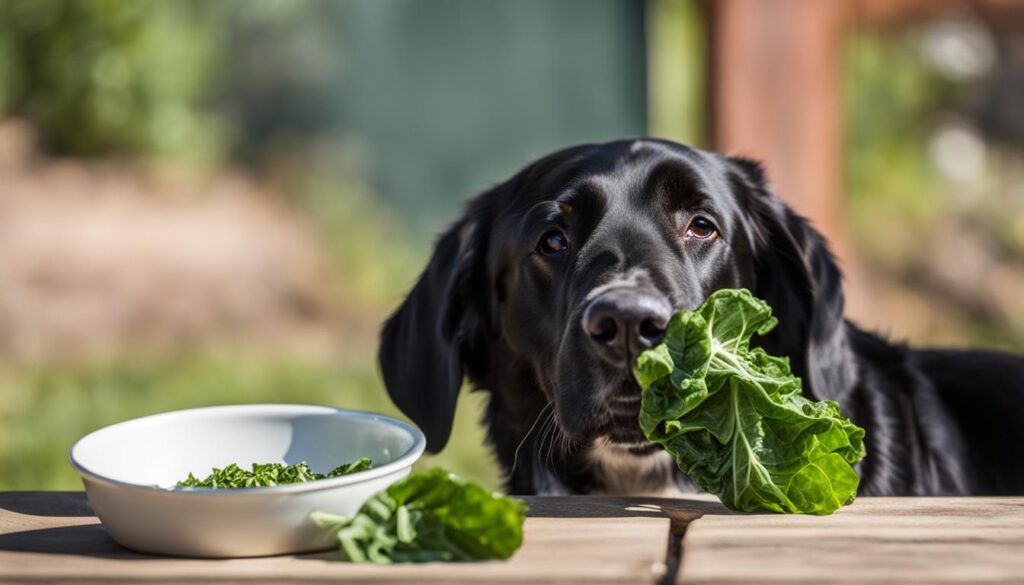Uncovering if Dogs Can Eat Collard Greens
Collard greens are a popular vegetable known for their numerous health benefits. As a dog owner, you may be wondering if collard greens are safe for your furry friend to consume. In this article, we will explore whether dogs can eat collard greens and the considerations to keep in mind when feeding them to your beloved pet.
Collard greens are rich in essential vitamins such as A, C, and K, folate, riboflavin, and fiber, making them a nutritious choice for both humans and dogs. However, it is important to note that not all vegetables are safe for canine consumption. So, let’s dive into the specifics of collard greens and their suitability for dogs.
Key Takeaways:
- Collard greens are not toxic to dogs and can be a beneficial addition to their diet when served correctly.
- Dogs with bladder or kidney issues should avoid collard greens due to their high levels of isothiocynates and calcium oxalate, which can contribute to the formation of bladder and kidney stones.
- It is recommended to serve only the leaves of collard greens, as the stems are harder to digest and can cause digestive issues such as diarrhea.
- Steaming the leaves before serving can help soften them and make them easier for dogs to eat and digest.
- Always consult with your veterinarian for guidance on serving sizes and any potential risks specific to your individual pet.
The Nutritional Value of Collard Greens for Dogs
Collard greens are a nutritional powerhouse for dogs, providing a range of essential vitamins and minerals that contribute to their overall health and well-being. Including collard greens in your dog’s diet can offer numerous nutritional benefits, helping to support their immune system, bone strength, energy production, and digestion.
When it comes to vitamins, collard greens are particularly rich in vitamins A, C, and K. Vitamin A is essential for good vision, immune function, and cell growth. Vitamin C is a powerful antioxidant that supports the immune system and aids in collagen production. Vitamin K is crucial for proper blood clotting and helps maintain healthy bones.
Collard greens are also packed with other essential nutrients. They are a great source of folate, a B vitamin that plays a vital role in cell growth and DNA production. The presence of riboflavin in collard greens helps with energy production, while fiber promotes regular digestion in dogs.
In addition to vitamins, collard greens contain important minerals like manganese and calcium. Manganese is necessary for proper metabolism and the formation of connective tissues. Calcium is crucial for strong bones and teeth, nerve function, and muscular contractions.
To ensure proper digestion and avoid potential digestive issues, it is important to serve only the leaves of collard greens to your dog. The stems can be harder to digest and may lead to gastrointestinal discomfort. Steaming the leaves before serving can soften them, making it easier for dogs to eat, digest, and absorb the nutrients.

Summary of Nutritional Value
| Nutrient | Benefit for Dogs |
|---|---|
| Vitamin A | Supports vision, immune function, and cell growth |
| Vitamin C | Aids in immune function and collagen production |
| Vitamin K | Supports blood clotting and bone health |
| Folate | Essential for cell growth and DNA production |
| Riboflavin | Aids in energy production |
| Fiber | Promotes regular digestion |
| Manganese | Supports metabolism and connective tissue formation |
| Calcium | Essential for bone health, nerve function, and muscle contractions |
By incorporating collard greens into your dog’s diet in a safe and appropriate manner, you can provide them with a variety of valuable nutrients. However, it is important to keep in mind that each dog’s nutritional needs may vary. Always consult with your veterinarian to determine the right amount and frequency of feeding collard greens to your furry friend.
Potential Risks and Precautions of Feeding Collard Greens to Dogs
While collard greens have many nutritional benefits for dogs, it is important to be aware of the potential risks and take certain precautions when feeding them to your furry friend. Collard greens contain high levels of isothiocyanates and calcium oxalate, which can pose problems for dogs with bladder or kidney issues. These compounds have been associated with the formation of bladder and kidney stones, so it is crucial to consult with your veterinarian before introducing collard greens into your dog’s diet, especially if your dog has any existing health conditions.
Another aspect to consider is the serving size. Collard greens should be served in moderation and in consultation with your veterinarian. While they provide numerous health benefits, excessive consumption can lead to gastrointestinal upset in dogs. Your veterinarian can guide you on the appropriate portion size based on your dog’s specific needs and health status.
It is also important to note that collard greens should be prepared and served properly to ensure their digestibility and safety for your dog. Always serve only the leaves of the collard greens, as the stems can be harder to digest and may cause digestive issues such as diarrhea. Steaming the leaves before serving can help soften them, making them easier for your dog to eat and digest.
Remember, your veterinarian is the best resource for advice and guidance regarding your dog’s diet. They can provide personalized recommendations based on your dog’s unique needs and health conditions, helping you make informed decisions about feeding collard greens or any other food to your furry companion.
| Potential Risks of Feeding Collard Greens to Dogs | Precautions for Feeding Collard Greens to Dogs |
|---|---|
| High levels of isothiocyanates and calcium oxalate may contribute to bladder and kidney stone formation | Consult with your veterinarian before introducing collard greens to your dog’s diet, especially if your dog has bladder or kidney issues |
| Excessive consumption can lead to gastrointestinal upset in dogs | Feed collard greens in moderation, following your veterinarian’s guidance on portion sizes |
| Stems of collard greens may cause digestive issues such as diarrhea | Serve only the leaves of collard greens and steam them to improve digestibility |
Safe Preparation and Serving Methods for Collard Greens
When it comes to preparing and serving collard greens to your furry friend, it’s crucial to follow safe methods to ensure their digestibility and maximize their nutritional benefits.
Can dogs eat collard greens? Absolutely! Collard greens are considered dog-friendly greens and can be a healthy addition to your dog’s diet. However, it’s important to serve them in the right way to ensure optimal safety and nutrition for your canine companion.
Here are some safe preparation and serving methods for collard greens:
- Use only the leaves: When serving collard greens to your dog, it’s best to use only the leaves. The stems can be harder to digest and may cause digestive issues for your dog. Discard the stems and focus on the tender leaves to ensure easy digestion.
- Steam the leaves: Steaming the collard greens leaves can help soften them, making them easier for your dog to chew and digest. Steaming also helps retain more of the nutrients present in the leaves, ensuring your dog gets the maximum benefit from this dog-friendly green.
- Chop into small pieces: After steaming the leaves, chop them into small, bite-sized pieces. This makes it easier for your dog to eat and reduces the risk of choking. The smaller pieces also mix well with your dog’s regular food, ensuring they get the necessary nutrients from collard greens.
- Incorporate into your dog’s regular food: To introduce collard greens into your dog’s diet, mix the chopped leaves with their regular food. Whether it’s kibble or homemade meals, adding collard greens can provide an extra nutritional boost. Start with small amounts and gradually increase the serving size, based on your dog’s individual needs.
Remember, while collard greens are generally safe for dogs, every dog is different. Consulting with your veterinarian is always recommended, especially if your dog has any existing health conditions or specific dietary requirements.

Incorporating safe preparation and serving methods ensures that collard greens become a welcome addition to your dog’s meals. By following these guidelines and consulting with your veterinarian, you can confidently offer collard greens to your canine companion as a healthy and nutritious treat!
Conclusion
In conclusion, including collard greens in your dog’s diet can provide them with valuable nutrients and contribute to their overall health and well-being. Collard greens are a rich source of vitamins A, C, and K, as well as folate, riboflavin, fiber, manganese, and calcium – all of which support various aspects of canine health.
However, it’s important to exercise caution and be aware of potential risks. Dogs with bladder or kidney issues should avoid collard greens due to their high levels of isothiocyanates and calcium oxalate, which may contribute to the formation of bladder and kidney stones. Consulting with your veterinarian before introducing collard greens into your dog’s diet is crucial, especially if your dog has any existing health conditions.
When preparing collard greens for your furry friend, make sure to only serve the leaves, as the stems can be harder to digest and may cause digestive issues. Steaming the leaves and chopping them into small pieces can improve their digestibility and make them easier for your dog to consume. Serving collard greens in moderation, in consultation with your veterinarian, can ensure they are a safe and beneficial addition to your dog’s meals.
FAQ
Can dogs eat collard greens?
Collard greens are not toxic to dogs and can be safely included in their diet. However, there are certain considerations to keep in mind.
Are collard greens nutritionally beneficial for dogs?
Yes, collard greens are high in vitamins A, C, and K, folate, riboflavin, and fiber, making them a nutritious addition to a dog’s diet.
Are there any risks or precautions associated with feeding collard greens to dogs?
Dogs with bladder or kidney issues should avoid collard greens due to their high levels of isothiocynates and calcium oxalate, which can contribute to the formation of bladder and kidney stones.
How should collard greens be prepared and served to dogs?
It is important to serve only the leaves of collard greens, as the stems are harder to digest and can cause digestive issues. Steaming the leaves before serving can help soften them and make them easier for dogs to eat and digest.


